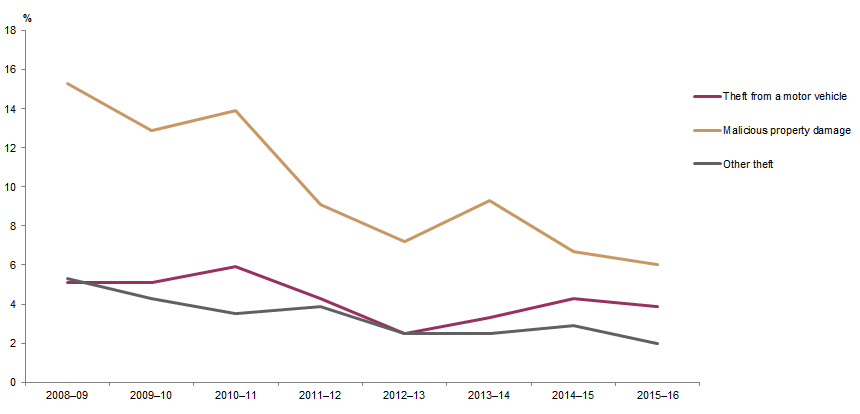AUSTRALIAN CAPITAL TERRITORY
HOW HAVE PERSONAL CRIME VICTIMISATION RATES CHANGED OVER TIME?
No graph for personal crimes in the Australian Capital Territory is presented, as no fitted functions or data series met the criteria for inclusion.
HOW HAVE HOUSEHOLD CRIME VICTIMISATION RATES CHANGED OVER TIME?
No fitted functions that met the inclusion criteria were identified for theft from a motor vehicle, malicious property damage or other theft in the Australian Capital Territory. Although no fitted function met the criteria for inclusion, there appears to be a decrease in the victimisation rate for malicious property damage since 2008–09. This finding should be used with caution.
VICTIMISATION RATES, Selected household crimes, Australian Capital Territory, 2008–09 to 2015–16(a)(b)

Australian Bureau of Statistics
© Commonwealth of Australia 2017.
Footnote(s): (a) The fitted functions used to analyse patterns of change in victimisation rates over time have not taken into account the survey error associated with the annual victimisation rates. This is expected to have limited impact on the analysis, as only survey estimates with RSEs of 15% or less were included in the analysis. For further information on survey error refer to the Technical Note. (b) Data for break-in, attempted break-in and motor vehicle theft are not shown, as estimates for the number of persons experiencing break-in and attempted break-in during the 12 months prior to interview are subject to high sampling error (for further details refer to the Technical Note).
Source(s): Crime Victimisation, Australia
 Print Page
Print Page
 Print All
Print All
 Quality Declaration
Quality Declaration